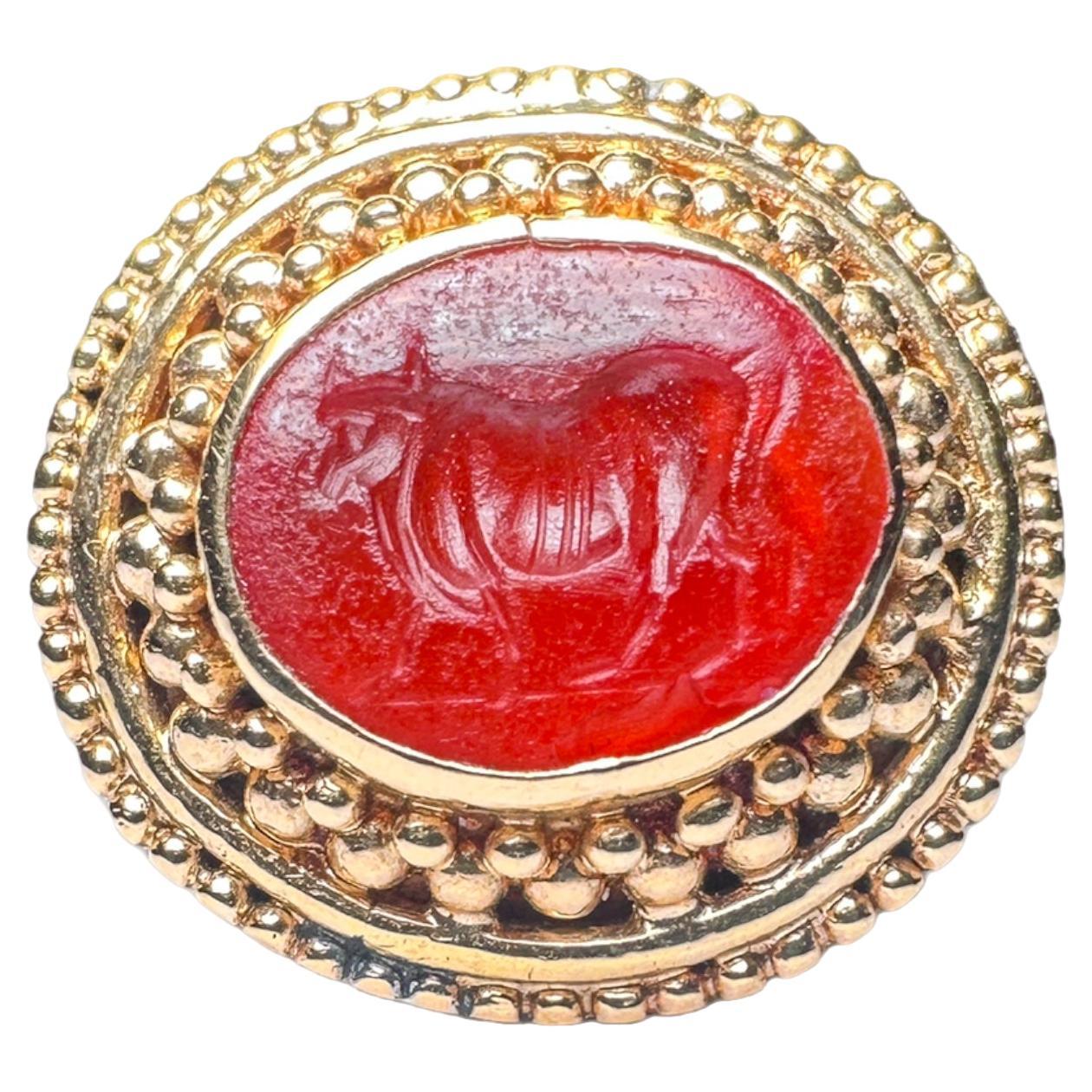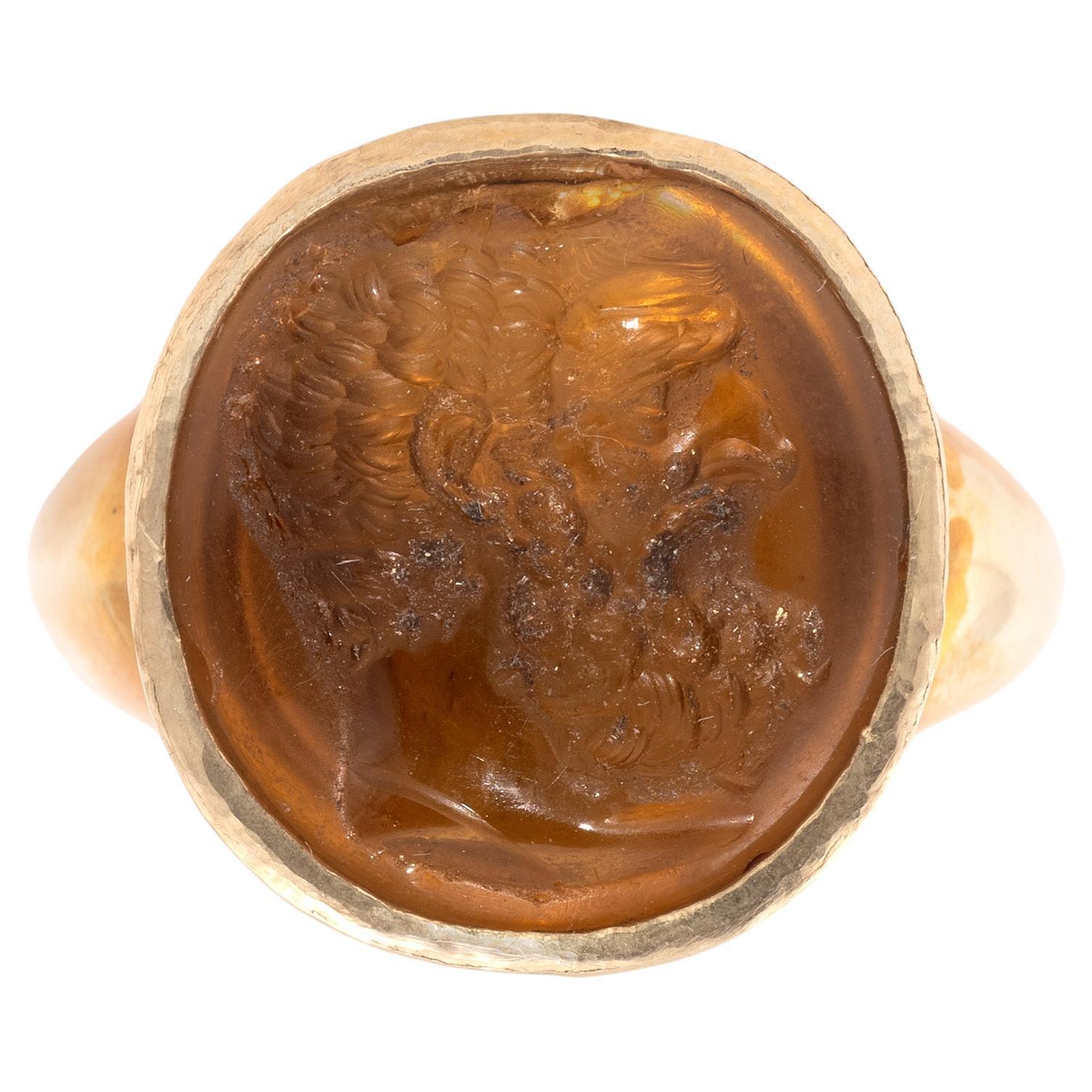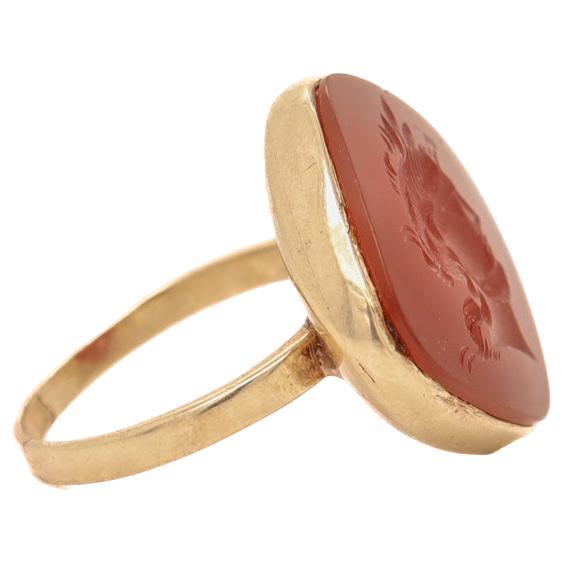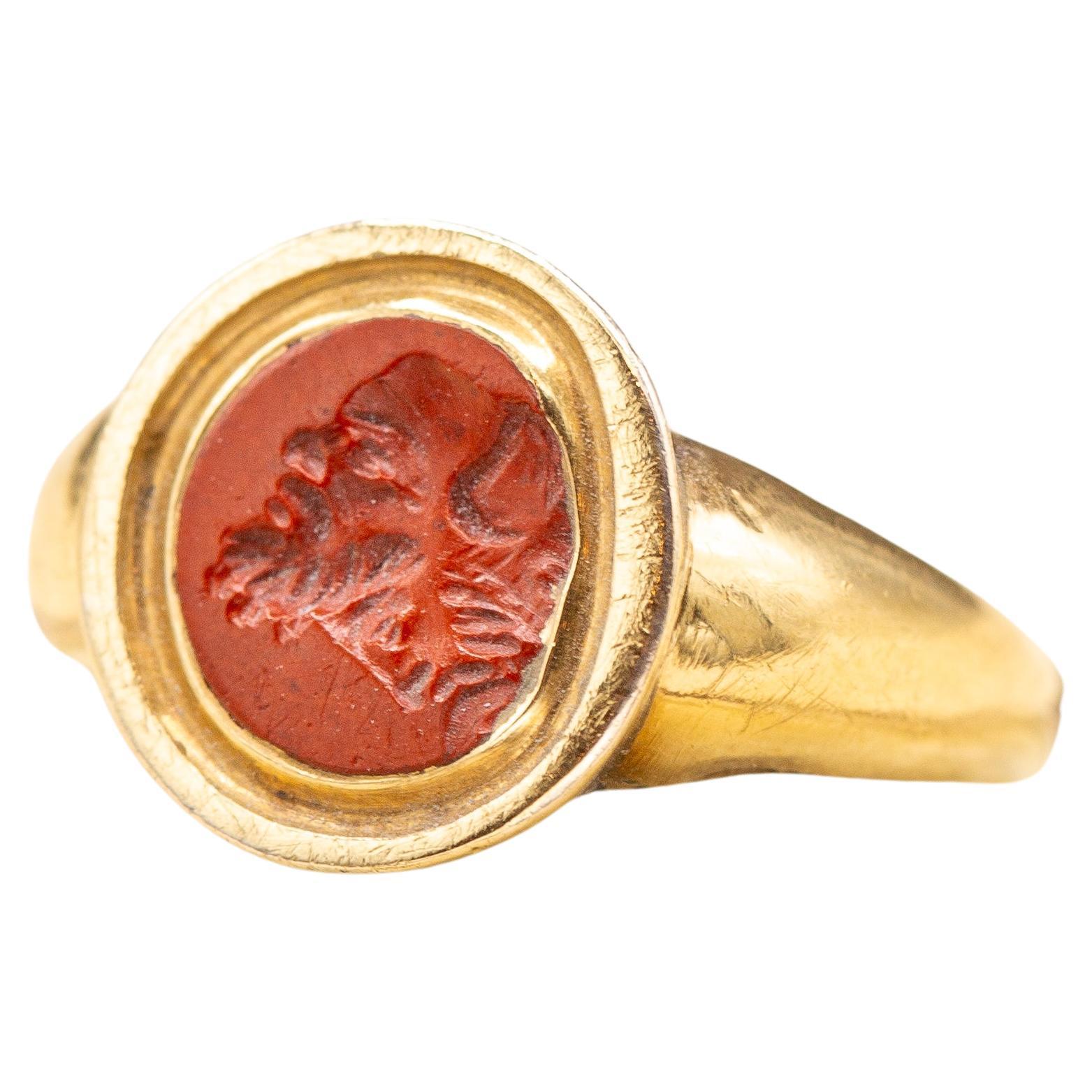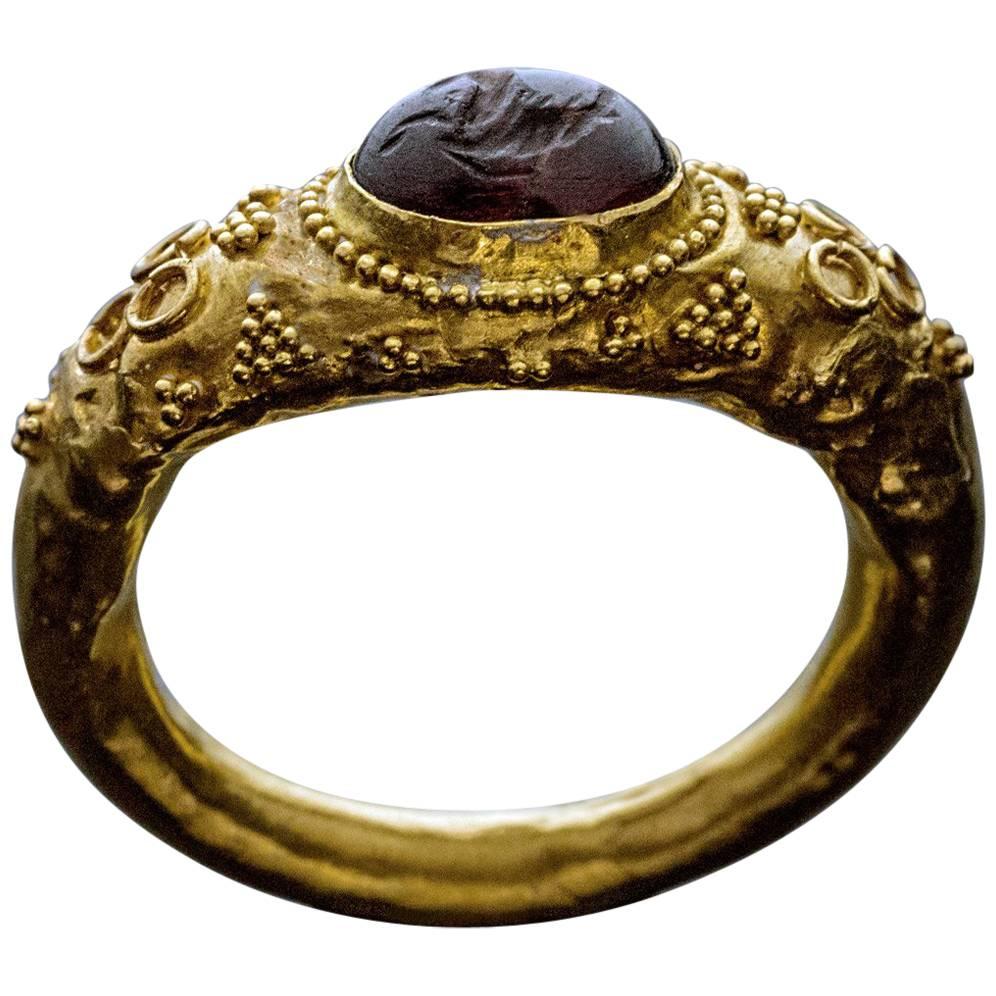Items Similar to Georgian 18th Century Signet Ring with Ancient Roman Nicolo Intaglio of Hercules
Video Loading
Want more images or videos?
Request additional images or videos from the seller
1 of 16
Georgian 18th Century Signet Ring with Ancient Roman Nicolo Intaglio of Hercules
About the Item
A superb ancient Roman nicolo intaglio set in a late 18th century gold signet ring. Nicolo intaglios are a particular type of intaglio made from sardonyx, agate, chalcedony or glass, whereby a thin lighter layer at the surface is carved away to reveal the darker background. This example is glass and has a light mottled blue layer over a dark blue ground. The intaglio dates from the 1st to 2nd century AD and probably depicts Hercules, the Roman God of strength and heroes. The subject was really appreciated in antiquity as a symbol of power, courage and virtue.
Glyptics have been admired since the start of the Roman Empire. This fascination has been revived throughout history, notably in the Renaissance period, and again during the Georgian and Victorian eras where many ancient cameos and intaglios were collected by young, aristocratic gentlemen during their ‘Grand Tour’ which led to the formation of significant collections. Like our example, many of these intaglios were set into jewellery, particularly in the late 18th and early 19th century; message for an image of other similar examples in the British Museum, Victoria & Albert Museum and the Metropolitan Museum of Art.
The carved stone is set in a classic rubover setting with a grooved bezel, flared shoulders and plain tapering band, typical of the period. The ring is crafted in 18K gold and has a fantastic smooth silk-like texture commensurate with its impressive age.
UK size O, US size 7, intaglio measures 11mm x 9mm
- Ring Size:7 US, Resizable
- Weight:3 g
- Style:
- Place of Origin:
- Period:
- Date of Manufacture:1799
- Condition:
- Seller Location:London, GB
- Reference Number:1stDibs: LU2845219121482
Resizing is available.
About the Seller
5.0
Vetted Seller
These experienced sellers undergo a comprehensive evaluation by our team of in-house experts.
Established in 2019
1stDibs seller since 2022
32 sales on 1stDibs
Typical response time: 14 hours
- ShippingRetrieving quote...Ships From: London, United Kingdom
- Return PolicyA return for this item may be initiated within 14 days of delivery.
More From This SellerView All
- Ancient Roman Carved Red Jasper Gryllus Signet Ring Antique GeorgianLocated in London, GBAn ancient Romano-British carved jasper intaglio dating from the 2nd to 3rd century AD, set in a later gold mount dating from the late 18th century. The intaglio is intricately carve...Category
Antique 15th Century and Earlier Italian Georgian Signet Rings
MaterialsJasper
- Ancient Roman Green Chalcedony Plasma Intaglio Ring of Goddess Victoria NikeLocated in London, GBA scarce ancient Roman intaglio dating from the 1st to 2nd century AD, depicting Victoria, the Roman Goddess of Victory (also known as Nike in Greek mythology). The cabochon gemstone is a chromium chalcedony, mottled green in colour. It was known in the ancient world as a ‘plasma’ stone and was widely used in jewellery and seals throughout the Roman Empire. However the mineral disappeared from use in the ancient world towards the end of the 2nd century AD when the known deposits were mined out. The intricate ancient engraving depicts a winged Victoria, draped and facing left, holding a palm branch in her right hand and a laurel leaf in her left. The green gem is translucent and contains small dotted black natural inclusions. The gemstone’s viridian green tones were linked to nature, growth, and prosperity, reflecting the Romans' appreciation for abundance and fertility. Victoria played a major part of Roman society, with many temples erected in her honour including one on the Palatine Hill which would house the spoils of war from Roman victories. She was, to the Romans, a symbol of victory over death, ultimately determining who would be successful during war. The high number of artistic and architectural dedications to her bear witness to the popularity of the goddess’ cult: Victoria widely appears on Roman coins...Category
Antique 15th Century and Earlier Italian Classical Roman Signet Rings
MaterialsChalcedony, 22k Gold
- Antique 17th Century Engraved Silver Heraldic Coat of Arms Intaglio Signet RingLocated in London, GBThis rare heraldic silver intaglio signet ring dates from the late 17th century and originates from Western Europe. The flat, octagonal bezel is engraved with a noble family coat of arms depicting an eight pointed star. The silver ring is cast in one piece, the intaglio is framed within a chased octagonal border and the band displays flared and chamfered edges at the shoulders, all features typical of the period. After looking into heraldry archives, there are a few families in Western Europe which share this coat of arms, notably the Ambrogini family of Italy and the Counts of Waldeck, vassals of Luxembourg since the 14th century (see Ravensbury Antiques...Category
Antique Late 17th Century European Stuart Signet Rings
MaterialsSilver
- Important Antique Finnish 18K Coat of Arms Klinckowström Intaglio Signet RingLocated in London, GBA superb, scarce Finnish antique 18K gold ring that was made in Helsinki in the year 1854. The oval carnelian coat of arms intaglio is set in a large intricate gold repoussé work mount featuring scrolled foliate motifs. Incredibly, thanks to a full set of Finnish hallmarks, as well as from the intaglio carving itself, we can identify who commissioned and wore this superb seal ring. The coat of arms engraved into the carnelian gemstone is that of the Klinckowström family, an old Prussian noble house whose members played prominent roles in the history of Prussia, Sweden, Finland and Austria. The family was granted nobility in Sweden in 1684 by King Charles XI, and then received the rank of baron in 1759 from King Adolf Frederick. The baronial branch was listed in the Finnish House of Nobility (Ritarihuone) from 1818 until the family line ended in Finland in 1883. This baronial element can also be seen in the engraved coat of arms from the specific type of coronet used, it is set with pearls and known as a ‘Friherrlig rangkrona’, the coronet for Baron. The hallmarks tell us that this ring was made in Helsinki in the year 1854. Accordingly, the ring must have been made for a Baron (male) of the Klinckowström family, present and active in Finland during the mid-19th century. After researching into the genealogial records, only one member of the family settled in Finland, which was Baron Otto Wilhelm Klinkowström (1778-1850), and this ring would have been commissioned by his son Baron Arthur Wilhelm Wilhelmsson Klinckowström, shortly after his father’s passing. The ring would have been made in used to seal deeds and important letters in wax regarding family affairs. Arthur had two sons. Emil and Alexander who carried on the baronial title until 1883, when the family line ended on the male side. Although the time period of this ring also matches up with his both his sons, according to heraldry records they both carried a slightly different coat of arms. Arthur, the owner of this ring enrolled in the House of Knights in Finland aged 17 and soon after received the Order of St. John of Jerusalem. He spent the remainder of his years in various senior military positions, such as Lieutenant Colonel of the Finnish Sharpshooter Battalion and Colonel of the Kremenchugska Hunter Regiment. He passed away in 1860, not long after his father, which may explain why this ring is in such excellent condition with minimal signs of usage. His father, Baron Otto Wilhelm Klinkowström (1778-1850) was a Swedish lieutenant general who later moved to Finland, where he immediately found favour with Czar Alexander I of Russia...Category
Antique 1850s Finnish Victorian Signet Rings
Materials18k Gold
- Antique Italian 18th Century Georgian Gold Cameo Ring Bust of Medusa HardstoneLocated in London, GBA gorgeous 18th century Italian hardstone cameo ring. This beautiful four layered sardonyx cameo is carved from a single piece of agate with immense skill to reveal the bust of the G...Category
Antique Late 18th Century Italian Neoclassical Signet Rings
MaterialsAgate, Gold, 22k Gold
- Georgian Gold and Carnelian Signet Ring Large 19th Century Antique Seal RingLocated in London, GBA large antique English Georgian era gentleman’s gold signet ring, circa 1830. In the centre there is a flat-cut and bezel-set octagonal carneli...Category
Antique Early 19th Century British Georgian Signet Rings
MaterialsCarnelian, Gold
You May Also Like
- 18K Gold Roman Intaglio Ring with Bull SignetLocated in London, GBIndulge in the captivating allure of this beautiful Roman intaglio ring, meticulously crafted in luxurious 18K gold. This exceptional piece showcas...Category
Antique 15th Century and Earlier Italian Classical Roman Signet Rings
MaterialsCarnelian, 18k Gold
- Antique Gold & Carved Carnelian Intaglio Signet Ring with an Ancient Roman HeroLocated in Philadelphia, PAA fine antique intaglio ring. Likely converted from an antique button or pin. In 14k gold With a carved carnelian cabochon depicting an unidentified Roman hero. Marked 14k to the...Category
20th Century Etruscan Revival Signet Rings
MaterialsCarnelian, Gold
- A Roman Citrine Intaglio Of Hercules 1st Century AD RingLocated in Firenze, ITA Roman intaglio carved in a lentoid citrine. The subject is a vigorously engraved bust of Hercules to the right. The subject is beautifully rendered with the facial features in part...Category
Antique 15th Century and Earlier Italian Classical Roman Signet Rings
MaterialsCitrine, 18k Gold, Yellow Gold
- Ancient Roman Garnet Intaglio Gold RingLocated in Chicago, ILA museum quality ancient Roman gold ring, circa 400 AD. This hollow ring is bezel-set with a garnet intaglio of Hippocamp – a fish-tailed horse that w...Category
Antique 15th Century and Earlier Signet Rings
- Ancient Roman Amethyst Intaglio Gold RingLocated in Chicago, ILRoman, circa 2nd – 1st centuries BC A museum quality, finely modeled, high carat (approximately 22.5K), hollow gold signet ring is set with an oval amethyst intaglio...Category
Antique 15th Century and Earlier Signet Rings
MaterialsAmethyst, Gold
- Ancient Roman Carnelian Intaglio Ring with Clasped HandsLocated in Stamford, CTWe are proud to show this circular hoop of 22 Kt gold, with coiling around the shoulders, sets an oval shaped intaglio"dextrarum lunctio" on the carnelian. This translates to clasped...Category
Antique 15th Century and Earlier Italian Classical Roman Band Rings
MaterialsCarnelian, 22k Gold
Recently Viewed
View AllMore Ways To Browse
Images Of Antique Rings
Carved Stone Roman
18k 18th Century Ring
Banded Agate Ring
Ancient Cameo
Late Roman Ring
Roman Era
Banded Agate Ring Gold
Gentlemens Gold
Gold Gentlemen
Blue Cameo Glass
Antique Blue Cameo
Metropolitan Museum Of Art Jewelry
Metropolitan Museum Art Jewelry
2nd Empire
Blue Cameo Jewelry
Victorian Lighter
Banded Agate Gold Victorian
